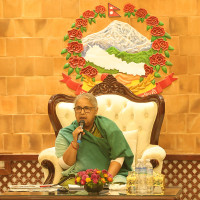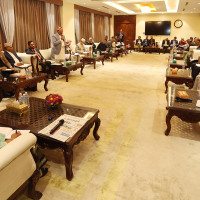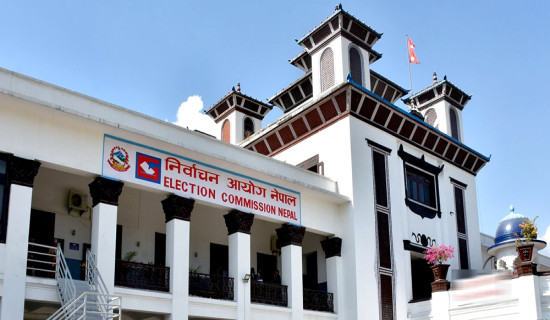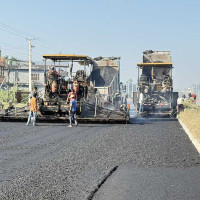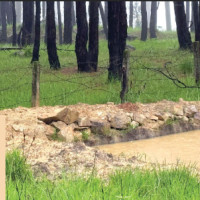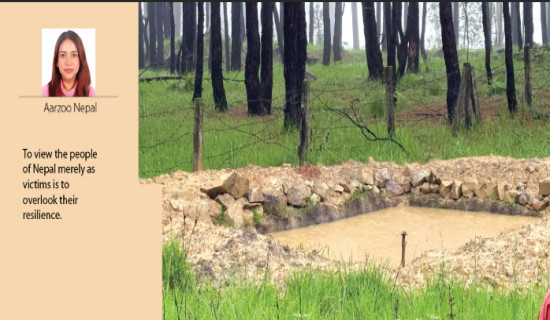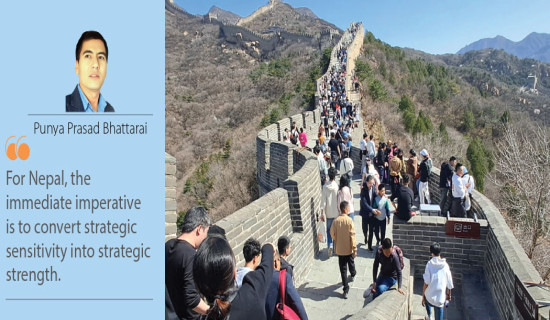- Saturday, 6 December 2025
Changing World, Steady China-Nepal Friendship
Prime Minister Prachanda's visit to China came to a successful conclusion, when his return flight arrived at Tribhuvan International Airport in Kathmandu. Just like the plane flying over the boundary peak, Mount Qomolangma, this visit has once again witnessed a new height of friendship between the two countries. In a world of change and turmoil, the unchanging friendship between China and Nepal is particularly precious and should be cherished even more.
China attaches great importance to the foremost high-level exchanges between China and Nepal after the COVID-19 pandemic. President Xi Jinping had a cordial meeting with Prime Minister Prachanda along the West Lake in Hangzhou, Zhejiang Province. Prime Minister Li Qiang held a grand welcome ceremony in Tian’anmen Square and held talks with Prime Minister Prachanda. Zhao Leji, Chairman of the Standing Committee of the National People's Congress of China, met with Prime Minister Prachanda. During his visit of five provinces in China in eight days, Prime Minister Prachanda attended the opening ceremony of the 19th Asian Games Hangzhou, visited Huawei's latest technology display and Chongqing's modern agriculture, gained an in-depth understanding of the economic and social development plans of Chongqing Municipality, Xizang Autonomous Region, and Sichuan Province. Prime Minister Prachanda not only personally witnessed China's rapid development, but also strengthened the ever-lasting friendship between our two countries.
This visit is of great significance in enhancing the strategic partnership of cooperation featuring ever-lasting friendship for development and prosperity between the two countries. When meeting with President Xi Jinping, Prime Minister Prachanda reiterated that Nepal firmly adheres to the one-China principle and will never allow any organisation or person to use Nepali territory to engage in any anti-China separatist activity. President Xi Jinping expressed that China is willing to help Nepal transform from a "landlocked country" to a "land-linked country" and facilitate Nepal's economic and social development. Premier Li Qiang and Prime Minister Prachanda witnessed the signing of more than ten bilateral cooperation documents covering economy and trade, agriculture, science and technology, culture, publishing, digital economy, green and low carbon, inspection and quarantine, and development assistance. The two countries also issued a detailed joint statement, guiding the way forward for promoting exchanges and mutually beneficial cooperation at all levels between the two countries.
This visit injected strong impetus into high-quality Belt and Road cooperation and accelerating the construction of China-Nepal Trans-Himalayan Multi-Dimensional Connectivity Network. The two countries expressed their commitment to accelerating the consultations to finalise the text on the BRI Implementation Plan at an early date and promoting connectivity in various fields. The Lizi-Nechung port was successfully opened. The passager and cargo services at the Pulan, Jilong, Zhangmu-Khasa ports were operated smoothly and orderly. The restoration of traditional border trade points has been accelerated, transit transport and utilisation of highways in China have been strongly implemented. Promising results have been achieved in the fourth phase of the Araniko Highway maintenance project, repair work of the Syaphrubesi-Rasuwagadhi Highway, the feasibility study of the Tokha-Chhare Tunnel project, the second phase of the Kathmandu Ring Road project, and the feasibility study of the Jilong/Keyrung-Kathmandu Cross-Border Railway. The two sides also reached consensus on expanding the air rights arrangements, developing hydropower, and signed MOUs on using Chinese aid to launch new projects such as the Hilsa-Simikot road construction in the first phase of the Karnali Provincial Corridor and cross-border power grid under the framework of the “Belt and Road”. The Himalayas are expected to become a springboard for Nepal's development.
This visit also provides a good recipe for expanding China-Nepal cooperation in various fields and promoting Nepal's economic transformation. The China-Nepal Business Summit and the Second Working Group Meeting on Trade Facilitation were held in Beijing. Both sides pledged to provide a fair, transparent and non-discriminatory business environment for each other’s business investment and operation. The first batch of transit cargo on September 7, 2023 from the third country to Nepal by utilising Chinese transit facilities under the Transit Protocol signed between Nepal and China successfully arrived in Nepal. Nepali haylage was successfully exported to China. The Protocol of Phytosanitary Requirements for Export of Plant-derived Medicinal Materials for the Chinese Medicine from Nepal to China was signed. These are positive steps forward to reducing trade imbalance between the two countries. The China-Nepal Friendship Industrial Park and the Agriculture Industrial Demonstration Park have made positive progress. Technical exchanges and cooperation in yak and goat (Chyangra) breed selection and standardised large-scale breeding have expanded. The two sides have also reached cooperation agreements in various areas such as poverty alleviation and development, improvement of people's livelihood, rural revitalisation, medical and health care, law enforcement cooperation and education. China actively supports Nepal's tourism promotion and agrees to declare 2025 as the "Nepal Tourism Year" in China.
This visit also provides stabilising factors into the regional situation. Nepal supports the important initiatives proposed by President Xi Jinping. The two countries announced to build a global community of shared future, stressed the importance to uphold true multilateralism and make global governance more just and equitable. The two sides agreed to strengthen cooperation within the framework of the United Nations and other multilateral mechanisms to uphold the common interest of developing countries. The two sides support the multilateral trading system, and oppose protectionism. They will work together to make economic globalisation more open, inclusive, balanced and beneficial for all, promote global and regional peace, security, development and prosperity.
In 1260 A.D., Araniko, a Nepali architect, went to China and presided over the construction of many temples and pagodas in China. Among them, the Miaoying Temple, also known as White Pagoda Temple, which has been standing for nearly 800 years, has become one of the city symbols of Beijing and witness of China-Nepal friendship that has been lasting for thousands of years. Prime Minister Prachanda's visit is the continuation of the friendship between the two countries as well as the beginning of in-depth cooperation between China and Nepal in the future. China is ready to work with Nepal to implement the important achievements of President Xi Jinping's state visit to Nepal and the consensus reached by our two leaders during Prime Minister Prachanda’s visit to China, jointly build the high quality Belt and Road, accelerate the construction of China-Nepal Trans-Himalayan Multi-Dimensional Connectivity Network, so as to build a closer China-Nepal community of shared future, and bring more benefits to the two countries and their peoples.
(The author is China's Ambassador to Nepal.)




